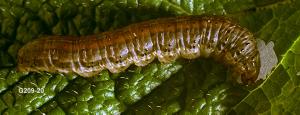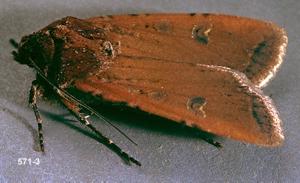|
Return to:
[Redbacked
Cutworm Identification]
[Insect
Management]
[Home]
|
|
 |
 |
| Redbacked Cutworm Larva (5th instar) |
Redbacked Cutworm Adult |
Redbacked cutworm, black cutworm and other Euxoa
species are pests on mint East of the Cascade Mountains. However, black cutworm also may
occur in mint in western Oregon. Soil samples should be taken from mid-April through
June (Danielson, 1976, Danielson
and Berry, 1978). Wilted plants cut off at the soil surface and slow-growing mint in
the spring may indicate the presence of cutworms. The larvae can be seen on the foliage or
the soil surface on warm nights with a flashlight. Square foot soil samples to a depth of
2 to 3 inches should be taken in mint fields from early April to mid-June to determine if
these cutworms are present and numerous enough to warrant chemical control. At least one
soil sample should be taken for every 1 to 2 acres with a minimum of 25 samples per field.
The treatment threshold depends on the age and vigor of the field. See Shields and Berry
(1980), Soil Samples for Redbacked Cutworm in Peppermint, EC 1009, for detailed
information on the construction of sampling equipment, its use, treatment thresholds, and
sequential sampling for redbacked cutworms in differently aged fields.
Sequential sampling plans have been
developed for redbacked cutworm in different aged fields (Danielson 1976; Danielson and
Berry, 1978). For established fields, treatment is recommended if an average of 7.0
larvae/1000 cm² are found in 25 samples taken from different sites in the field.
Treatment is not recommended if the average number of larvae per sample is less than
3.0/1000 cm². In newly planted fields, treatment is recommended if an average of 1.5
larvae/1000 cm² are found in 25 samples taken from different sites. If the average number
of larvae per sample is less than 0.5/1000 cm², no treatment is necessary. Vigorously
growing plants can withstand more cutworm injury than plants growing under stress. In
addition, fields greater than 6 to 8 years old that have other pests such as weeds,
nematodes, or diseases are likely to be more susceptible to cutworm injury.
Natural parasites occur in mint fields in central Oregon and have been shown to decrease
the populations of Euxoa spp. by as much as 80 per cent. The principal parasites
in areas east of the Cascade Mountains are Porizintinae species and Copidosoma
spp.
If treatment is justified, refer to the section on registered insecticides for a list of
insecticides and rates that can be used on mint to control
redbacked cutworm. |


